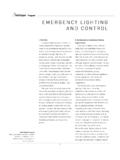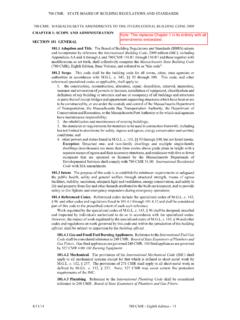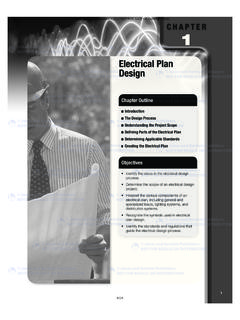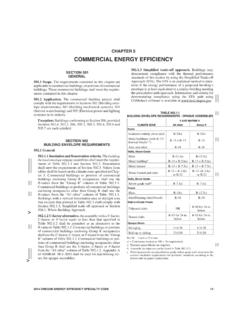Transcription of Commercial Lighting Requirements of the 2006 …
1 Commercial Lighting Requirementsof the 2006 international EnergyConservation Department of energy Building energy Codes ProgramEric Richman, PNNLM aterials developed by: Eric Richman, PNNL and Britt/Makela Group, We Plan to Some history and basis for energy codes and standards Why we have them Where they apply Specific Requirements Focus on IECC 2006 Comparisons with other codes/standards where applicable Intent and application The intent of major Requirements What the Requirements mean in actual practiceSome History: The Basis for energy Requirements energy conservation and Production Act, as amended, requires States to adopt a Commercial energy drives state adoption of energy codes DOE determines the effective stringency level to meet or exceed currently set at ASHRAE/IESNA Many code /standard versions available and currently adopted varies by state: Some adopt nationally available codes/standards Some develop state-specific codes Some have no code !
2 CODESFEDERALE nergy Codes/StandardsEnergy Codes/Standards83 MEC83 MEC89 MEC89 MEC77 MCEC77 MCEC90-197590-197592 MEC92 MEC95 MEC95 MEC93 MEC93 MEC00 IECC00 IECC98 IECC98 IECC02 IECC02 IECC01 IECCNFPA900 NFPA900 03 IECC03 IECC04 IECC10 CFR434 FEDCOM I10 CFR434 FEDCOM I10 CFR434 FEDCOM II10 CFR434 FEDCOM MEC86 MECSTANDARDS10 CFR 435 FEDCOM 010 CFR 435 FEDCOM CFR 435 COSTSAFR10 CFR 435 COSTSAFRFEDRESFEDRESC odified IECC06 IECCSTATE SPECIFIC (Unique or based on a code /Standard) Commercial Lighting Requirements in IECC 2006 Commercial provisions contained in Chapter reference to ASHRAE Covers Lighting controls and power density for interior and exteriorException: Lighting within dwelling units Major changes in the 2006 version Revised Interior Lighting Power Allowances New Lighting Power Densities for Building ExteriorsThe IECC code Compliance ProcessMust the Project Comply with the IECC?Comply with the Envelope RequirementsComply with the Mechanical RequirementsComply with the Power & Lighting RequirementsSection Section 5 Section Section 6 Section Section 9 Document Compliance with the IECCPlan ReviewInspectionDoes My Project Need to Comply with the Commercial Requirements of IECC ?
3 First: Is IECC ( 2006 ) the applicable code in your state or jurisdiction?..If yes, is the building commercialor high-rise residentialother than: One- and two-family residential R-2, R-3, R-4 three stories or less in heightWhen do the Lighting and Power Requirements Apply? Original Installed Lighting System in a New Building, Addition, or Tenant Build-out Existing Lighting System that is Altered Change in Occupancy that Increases EnergyExceptions: Historic buildings State or National listing Eligible to be listed Lighting within dwelling unitsThe IECC code Compliance ProcessMust the Project Comply with the IECC?Comply with the Envelope RequirementsComply with the Mechanical RequirementsComply with the Power & Lighting RequirementsSection Section 5 Section Section 6 IECCS ection 9 Document Compliance with the IECCPlan ReviewInspectionIECCS ection 506 Building PerformanceMethodWhat s Covered Under Electrical Power and Lighting System Requirements ?
4 Mandatory Interior Lighting Requirements Required Controls Wattage/Efficiency Limits Interior Lighting Power Allowances (watts/ft2) Exterior Lighting Controls Required Controls Lamp Efficiency Exterior Lighting Power Allowances (watts/ft2) Electric MeteringInterior Lighting Control ( ):Basic ControlIndependent Lighting Control required for each space surrounded by floor-to-ceiling partitions Must be located in the space served, -or - Switched from a remote location Must have indicator that identifies the lights served and their status (off or on) Exemptions Security or emergency areas that must be continuously lighted Lighting in stairways or corridors that are elements of the means of egressIntent: Allow occupants to control unneeded Lighting !Interior Lighting Control: Light ReductionLight Reduction Controls must allow the occupant to reduce connected Lighting By at least 50% In a reasonably uniform illumination patternIntent: Allow occupants to moderate light levels to save energy !
5 Note: Alternate Standard ASHRAE/IESNA does not require Light Reduction ControlLight Reduction Control OptionsSSDimmer SwitchDAlternating LuminairesDimmingSSAlternating lamps Controlling all lamps or luminaires Dual switching of alternate rows of luminaires, alternate luminaires or lamps Switching middle lamp luminaires independently from the outer lamps Each luminaire or each lampInterior Lighting Control: Light Reduction ExemptionsLight Reduction Control Notrequired for the following: Areas with only one luminaire Areas controlled by occupancy sensor Corridors, storerooms, restrooms or public lobbies Sleeping units Spaces with < w/ft2 Interior Lighting Control: Automatic ShutoffAutomatic Lighting shutoff control device required in all buildings larger than 5,000 ft2 Building Defined: Any structure used or intended for supporting or sheltering any use or occupancy Building area surrounded by exterior walls and fire wallsExempted spaces Sleeping units Lighting for patient care When an automatic shutoff would endanger occupant safety or securityIntent: Eliminate after hours Lighting waste!
6 Interior Lighting Control: Automatic Shutoff Options1. Control lights on a scheduled basis (automatic time switch) Time-of-day controller Controls 25,000 ft2and not more than one floor, or2. Occupant sensor Turn lights off within 30 minutes of occupant leaving the space3. Signal from another control or alarm that indicates the area is unoccupiedOfficeOccupancy SensorConferenceRoomRestroomsLobbyConnec t to Lighting in LobbyOpen Bay OfficeConnect to Lighting in Open Bay OfficeAutomatic Lighting Control110 50 Automatic Lighting Shutoff Compliance OptionsInterior Lighting Control: Automatic Shutoff Override Automatic Time Switch Override Requirements Readily accessible Within view of the lights or area controlled Manually operated 2 hour override Controls an area 5,000 ft2 Exemptions to Override Requirements Can be over 2 hour override in malls and arcades, auditoriums, single-tenant retail space, industrial facilities and arenas when using captive key override Override in malls and arcades, auditoriums, single-tenant retail space, industrial facilities and arenas can cover up to 20,000 ft2 Interior Lighting Control.
7 Holiday Scheduling Automatic Time Switch Holiday Scheduling Must have feature that turns off all loads for 24 hours then resumes the normally scheduled operation Retail stores and associated malls, restaurants, grocery stores, places of religious worship and theaters are exemptInterior Lighting Control: Sleeping Unit Lighting Control Sleeping Unit Control Applies to Hotel/Motel Guest Room, boarding houses, or similar Master switch required at each room or main room entry Must control all permanently wired luminaires or switched receptaclesStandard RoomSuite$$$$$$$$$$$$$$$$$$$$Intent: Allow occupant to turn off lights at exit point!Tandem Wiring ( ) Tandem Wiring for all Odd Numbered Lamp Configurations Exceptions: Where electronic high frequency ballasts are used Luminaires on emergency circuits Luminaires with no available pair in the same areaIntent: Eliminate the use of magnetic ballasts driving single lamps!
8 Exit Signs ( ) Exit Signs Internally illuminated exit signs shall not exceed 5 watts per sideInterior Lighting Power Limits ( )Connected Interior Lighting Power must not exceed Interior Lighting Power Allowance1. Calculate Interior Lighting Power Allowance Building Area type allowance Additional allowances2. Calculate proposed connected Lighting power Wattage calculation rules Exempted lighting3. Compare values: proposed wattage must be less than or equal to allowed wattageIntent: Eliminate waste from sloppy Lighting design and application!Interior Lighting Power Allowances New for the 2006 version: Building Area Type Only! Retail Additional Allowance Only!Note: Alternate Standard ASHRAE/IESNA provides whole building and space-by-space options This is a simplification of the previous 2003 version that included building and tenant area allowances plus decorative and medical additional allowancesInterior Lighting Power Allowance Calculation First, choose an appropriate Building Area Type from the allowance table ( ).
9 Building Area includes all spaces that are associated with that business or function type. For example a space with: Corridors, Restrooms, A lobby, and Office be considered an office Building Area Type the Lighting power density (W/ft2) by the building square footage to get allowed watts for complianceA 200,000 ft2office building that contains corridor, restrooms, break rooms and a lobby is given watt/ft2for the entire buildingOffice: 200,000 w/ft2= 200,000 wOffice - ExampleInterior Lighting Power Allowance for Multiple Occupancy BuildingHow is an allowance determined if the building has more than one Building Area Type?Example A building contains the following area types Museum:40,000 ft2 Retail:5,000 ft2 Cafeteria:10,000 ft2 Use the more specific building area type where more than one area type exists in the building Sum the individual ( Lighting power density X area square footage) values for Total Power AllowanceMuseum: 40,000 ft2at w/ft2= 44,000 wCafeteria:10,000 ft2at w/ft2= 14,000 wRetail:5,000 ft2at w/ft2= 7,500 wTotal watts allowed =65,500 wMultiple Occupancy Building - ExampleAdditional Retail Lighting Power Allowance (Table Footnote a ) Lighting installed to highlight specific addition Lighting Additional Lighting is added to the general Lighting allowances Lighting for merchandise display Add additional w/ft2X display area Display area cannot exceed 50% of the floor area Lighting for displaying and selling jewelry, china and silver w/ft2X the actual case or shelf areaNote.
10 Display Lighting must be switched or dimmed on separate circuit from general lightingIntent: Allow flexibility in design for critical retail applications!Museum: 40,000 ft2at w/ft2= 44,000 wCafeteria:10,000 ft2at w/ft2= 14,000 wRetail:5,000 ft2at w/ft2= 7,500 w + retail allowance:Wall Display (10X40) = 400 ft2at w/ft2= 640 wNew Total Allowance =66,140 wWith Retail - ExampleProposed Lighting Power Calculation Sum the wattage of all proposed connected Lighting power This must include all Lighting that is part of the design for the space including: Overhead Lighting Task Lighting Decorative lightingNote: Wattage must be calculated based on actual power just nominal lamp ratingProposed Lighting Calculation: ExampleLighting wattage must be documented in accordance with Section Screw lamp holders: maximum rated wattage of the luminaire Low voltage Lighting : transformer wattage Line voltage track: Use the GREATER of 30 w/linear foot or the actual wattage proposed for line-voltage track or plug-in busway Lighting Other.






